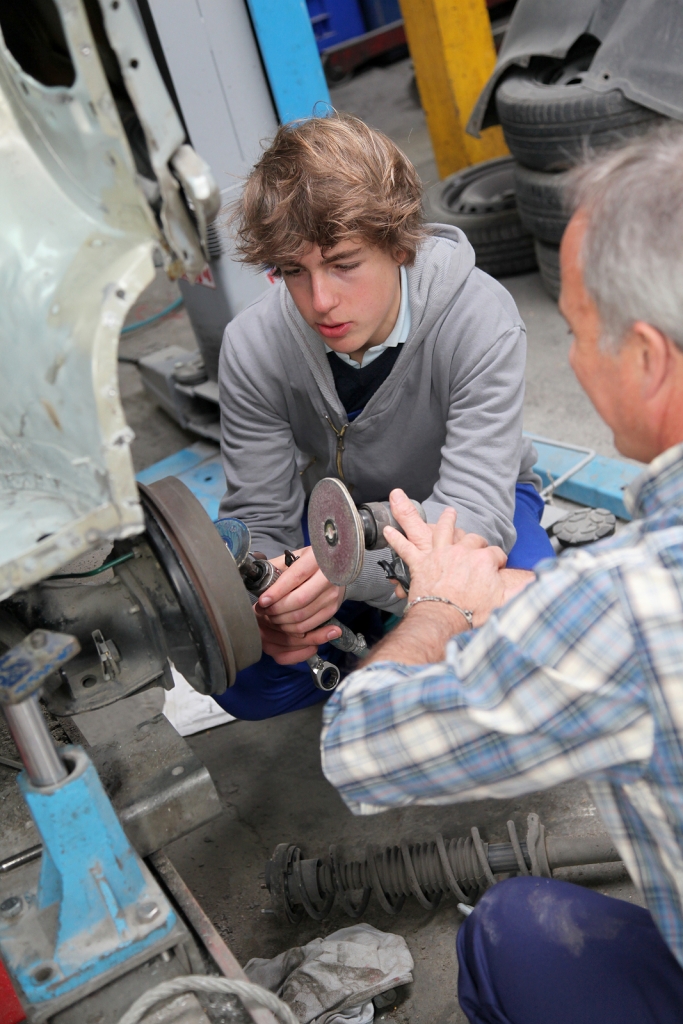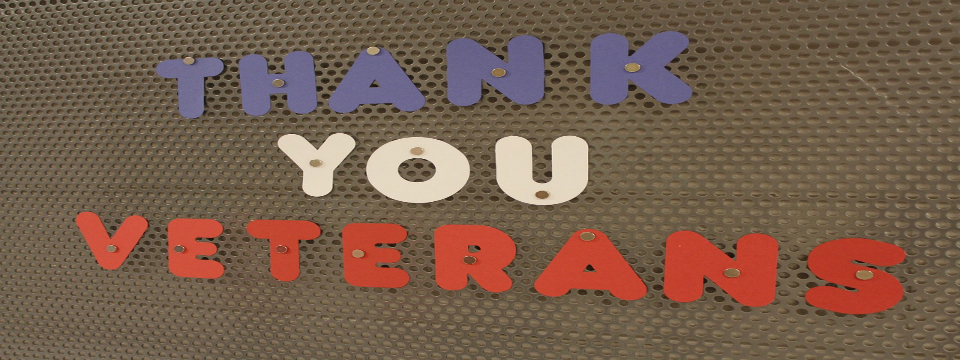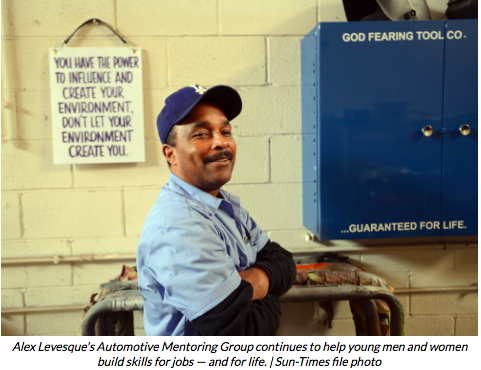New article on the re-emeregence of apprenticeships in U.S.
 Reprinted from the Chronicle of Higher Education
Reprinted from the Chronicle of Higher Education
By Aisha Labi, November 26, 2012
Apprenticeships Make a Comeback in the United States
Michael Aguilera, a student at Greenville Technical College, in South Carolina, and a participant in the BMW Scholars Program, learns from an employee at the company’s plant in Spartanburg. “It would be great to start a career here after college,” he says. His apprenticeship makes that much more likely.
When Michael Aguilera graduated from high school, in Woodmont, S.C., in 2009, he didn’t think he would ever find himself back in a classroom. But a “dead-end job” at a local auto-parts store and no success in applying for manufacturing positions that required more experience than his limited résumé could muster persuaded him to enroll at Greenville Technical College.
He soon learned about the college’s co-op programs, which allow students to gain working experience for which they can also earn course credits. He decided to apply to the BMW Scholars Program, a competitive apprenticeship that the German auto manufacturer runs in partnership with three local technical colleges.
For the past year, Mr. Aguilera has combined his studies for a two-year electrical-engineering degree with shift work, up to 25 hours a week, scheduled to accommodate his college responsibilities, at BMW’s Spartanburg plant. He hopes that when he graduates, BMW will offer him a permanent position. There is no obligation on the company’s side to do so, and none on Mr. Aguilera’s side to accept, but both would clearly benefit if it worked out. “It’s a great environment, and it would be great to start a career here after college,” he says.
Amanda Echols, a student in mechatronics at Spartanburg Community College, installs fasteners at the BMW plant. The company “can’t readily find those multiskilled employees out there who have all the mechanical, electrical, robotics, and other skills we need,” says the apprenticeship program’s director.
Such close connections between industry and academe, in which students simultaneously train and study, are gaining ground in the United States. Modeled after apprenticeship programs common in Northern Europe, most notably in Germany, they offer a possible solution to a problem that continues to vex the United States: a mismatch between what students are learning in the classroom and what employers say they need.
Even as U.S. unemployment figures remain stubbornly high, manufacturing facilities like BMW’s, which rely on workers with advanced technical skills, have difficulty filling positions. “As we’re growing and expanding, we’re adding more and more automation and robotics,” says Ryan Childers, who oversees BMW’s apprenticeship program, which comprises 55 students. “Here in South Carolina, we can’t readily find those multiskilled employees out there who have all the mechanical, electrical, robotics, and other skills we need.”
Mr. Aguilera knows that his credentials will give him a boost as he advances through the ranks. For its part, BMW stands to gain a fully trained employee familiar with how the company functions. “These students are receiving experience in our plants, working all the way through their degree, and earning valuable technical training,” says Mr. Childers. “At the end, even though there’s really no obligation for us to employ them full time, we’ve invested in them.”
BMW’s program, which it began in 2010, is inspired by the kinds of apprenticeships familiar to Europeans. Each year about half the graduates of German secondary schools begin apprenticeships that allow them to integrate work and study, both tailored to career development. They receive practical on-the-job training as well as theoretical instruction at vocational schools, roughly equivalent to American community colleges.
This so-called dual system, the main pathway for young people entering the work force directly from secondary school, is often invoked as one of the leading explanations for Germany’s relatively low youth-unemployment rate and high economic productivity. As a result, it is drawing increased scrutiny from educators, business leaders, and government officials in other countries, including the United States, eager to emulate Germany’s success.
A Growing Network
Apprenticeships have long played a role in training American workers, and as recently as the Clinton administration there was a concerted surge of interest in adopting the German model. But a number of states are now spearheading such programs. “Apprenticeships are making a comeback in the U.S.,” says Mr. Childers.
Once the province of traditional trades and under the control of organized labor, they are now being used to train workers in middle- and high-skills jobs in health care, information technology, and the service industry, among other fields. And their educational component is increasingly taking center stage. South Carolina, which is home to several companies based in Germany, has led the way, setting up a program in cooperation with the state’s technical-college system to foster the creation of apprenticeships, and offering tax incentives and consultants free of charge to employers to guide them toward recognition in the national Registered Apprenticeship system.
Robert B. Schwartz, a professor at Harvard University’s Graduate School of Education, has been immersed in the issues surrounding apprenticeships for decades. He is one of the authors of “Pathways to Prosperity,” a report published last year and unveiled at an event at Harvard attended by U.S. Education Secretary Arne Duncan. There is increasing evidence, Mr. Schwartz says, “that the proposition that most middle-class Americans bought into, that a four-year education was the ticket to success in the labor market, is no longer holding up.”
He cites statistics by researchers like Anthony P. Carnevale, director of Georgetown University’s Center on Education and the Workforce, who has found that more than 60 percent of bachelor’s-degree holders under 25 are unemployed or underemployed.
Mr. Schwartz and his colleagues are working with six states to develop different kinds of apprenticeship programs, in line with the report’s recommendations, and he expects one or two more to join the growing network.
“We’re not trying to sell the German dual-system approach,” he emphasizes. “What we are trying to do is basically say that the goal here is to build a set of pathways that start in high school and carry kids seamlessly into postsecondary education, through one- or two-year programs, based on the same principles that underlie the German system, through programs that align skills and work.”
Taking Off in Tennessee
So in Tennessee, for example, the report became a starting point for discussion among secondary and postsecondary educators, state officials, and local industry representatives at a conference held this year in Chattanooga by Volkswagen. Reflecting national statistics, around 80 percent of jobs in the state now require some postsecondary schooling, says Danielle Mezera, an assistant commissioner in the state Education Department’s Division of Career & Technical Education, There was a consensus at the conference about what she calls the “disconnect between academics and industry.”
Of particular concern is the perceived paucity of “soft” skills, such as critical thinking, communications, and teamwork, among graduates. Tennessee’s approach has centered on encouraging employer involvement in shaping curricula, in both secondary and postsecondary education.
The state has chosen two regions, an industrial area in the southeast and a more rural district in the north, in which to develop pathways programs. A project in the north, scheduled begin next fall, will establish a pre-engineering pathway, giving students hands-on experience in local companies beginning in middle school. Two local community colleges and one four-year institution will also take part.
Within a few years, state officials hope to have learned enough from those regional efforts to roll out a statewide apprenticeship strategy. Even at that point, Ms. Mezera expects there to be several different models, tailored to the varying levels of investment and commitment that companies are able to provide. “We have to be able to adapt to what the employer feels it can do,” she says.
Mr. Duncan has expressed cautious support for the recommendations of the “Pathways” report, saying that the system it envisions “constitutes a radical departure from the vocational education of the past.” But despite the endorsement, Mr. Schwartz notes that “the federal government’s role in vocational education is pretty modest.” This is a key difference from Europe, where national governments play a driving role in developing and administering apprenticeship systems.
Germany Not a Template
Those familiar with Germany’s dual system caution that it is a complex and finely tuned model that offers guidelines but not a template for other countries.
The fundamentals are straightforward. As in the United States, higher education is mostly the responsibility of state governments. But vocational education is the exception, with national agencies such as the Federal Institute for Vocational Education and Training overseeing all programs. The government identifies the 350 job categories for which apprenticeships exist and, in collaboration with industry and labor organizations, sets the framework for training, education, examination, and certification in each field.
Apprenticeships, most of which last around three years, are offered for white- as well as blue-collar jobs. The directory of apprenticeships in the Bonn area, for example, lists one at the American Institute for Foreign Study in tourism and another in technical software development at a meteorological company. Every profession has its own standardized body of regulation that the company and the vocational school must follow. So the process by which BMW trains apprentices in mechatronics, a field that combines elements of mechanical engineering, electronics, and other engineering specialties, at its Munich plants will be more or less the same as the way Mercedes-Benz does in Stuttgart, or Volkswagen in Wolfsburg.
In the United States, by contrast, although there is a national registry, the apprenticeship system is more state-driven. The Labor Department’s office of apprenticeship works with state agencies to administer the national program, and it is those state agencies that are responsible for promoting, developing, and overseeing apprenticeships on the local level.
Unique Relationships
Another key difference is the powerful role that German trade unions play in company management, professional education, and policy development, says Andreas König, who is a section head at GIZ, a federally owned company that assists the German government with its international advisory activities. In Germany, apprentices are eligible for the same benefits and protections that full-time employees enjoy, a formula that would be difficult to replicate in the United States. Still, “the core elements of the German system can be adapted and implemented in any other economy,” he says.
Most important to the system’s success in Germany, according to Mr. König, is the deep partnership that exists between governments and employers, both large and small. “This means that governments and employers have common interests in training in order to keep the economy competitive, and therefore jointly govern, plan, implement, and manage all training activities,” he says.
Persuading companies to invest in the training and education of young people who may not even end up as employees is one of the challenges for those involved in establishing German-style apprenticeship programs in the United States.
The fledgling engineering project in Tennessee has drawn the support of several regional companies, including some smaller firms, says Ms. Mezera, of the state education department. “We have to prepare the companies that these students may eventually leave their region and they have to be OK with that,” she says.
One of the strengths of the German-style apprenticeships is that they help to provide young workers with a broad, solid grounding, says James F. McKenney, vice president for economic development and international programs at the American Association of Community Colleges. Workers trained through the system are thought to be better equipped to handle not just the technical specifics of the jobs for which they have trained, but also the full range of challenges they will face in the workplace.
In other words, “they will be able to roll with the punches,” he says, just as advocates of liberal-arts degrees argue that students educated through that system will bring critical-thinking and analytical skills to bear on their lives and work.
Still, as the pace of economic change accelerates, Mr. McKenney questions how well suited the German system is to the new dynamics. One of the advantages of the American employment system, he says, is its ability to respond quickly to change. The rigor of the German system, with its emphasis on training and educating workers according to national prescriptions, can also lead to rigidity, he says. American hiring practices allow companies to shed and take on workers as demand dictates, while German companies have contractual obligations to employees, and instead of laying them off during down cycles have adopted reduced hours and job-sharing.
Some other countries have already adapted the German system in ways that may offer more-workable models for the United States. In Switzerland, for example, the labor market is less regulated, and youth unemployment levels are even lower than in Germany.
Subsidizing Others?
Even in Germany, the dual system, while a hallmark of industry, is not ubiquitous. The federal institute notes that 469 companies, or 22 percent of the total, offer dual training through apprenticeships. Companies are not obliged to take part in the system, and the costs associated with it can be a deterrent, especially since those that don’t participate can still reap the benefits by poaching workers who have been trained by other companies. But the system still provides the main means of entry into the work force for around 60 percent of the labor market.
And despite its broad public acceptance in Germany, even there the system has its critics. Companies pay for the programs but are highly subsidized by the government, and taxpayers end up shouldering up to 70 percent of the overall costs of the system, according to the federal training institute.
Germany has one of the lowest participation levels in higher education among developed countries, a deficit attributed to the large number of young people who take part in apprenticeships. Some Germans argue that the way the statistics are compiled unfairly discounts the postsecondary aspects of the dual system. Germany’s secondary schools, too, track students into vocational pathways much earlier than American schools do, and some German observers have long been concerned about the extent to which socioeconomic status factors into that process.
Such an approach would be unthinkable in the United States, where earning a college degree is the ambition for growing numbers of young people and their families, and vocational education has long been stigmatized.
Those working on adapting the dual system in the United States are hoping that the new generation of apprenticeships will shatter the stereotype that vocational education is only for students who can’t get into traditional higher education. “In today’s world, students have to go on to postsecondary education,” says Tennessee’s Ms. Mezera. “Yes, we have some ghosts of the past that we have to get over. But the only way we’re going to be able to do that is to focus on what is needed in the here and now.”










